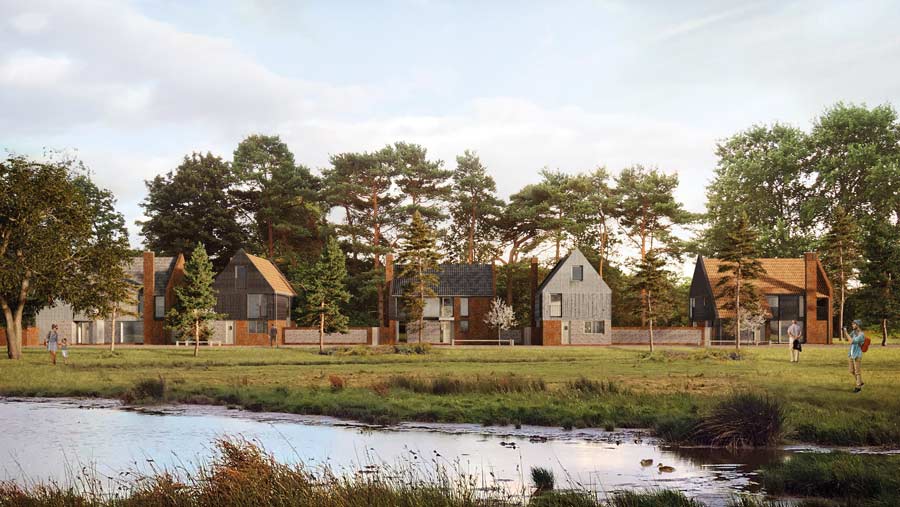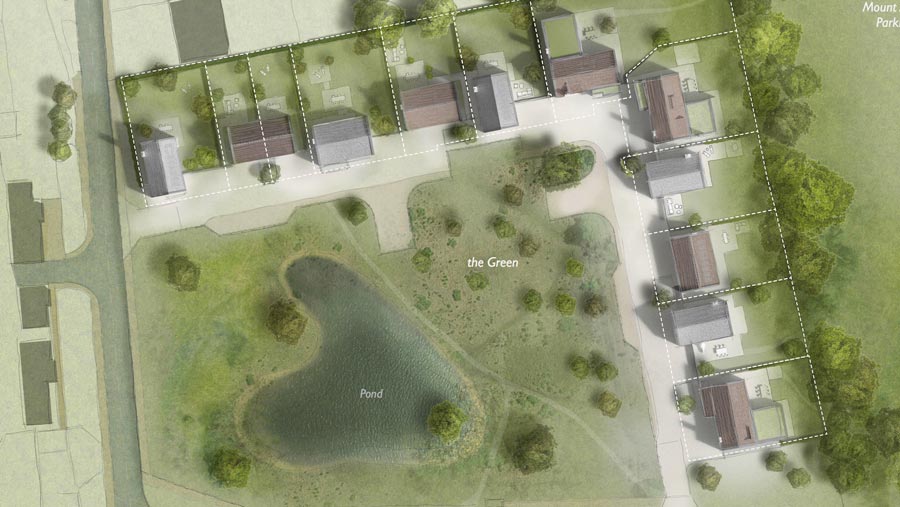Self-build demand creates opportunities for rural market
 Self-build site in Norfolk on grazing land, creating a new village green and pond © Livedin
Self-build site in Norfolk on grazing land, creating a new village green and pond © Livedin More than 50% of adults would reportedly build their own home, given the opportunity, but the two biggest barriers are finding land and navigating the planning system.
Working in their favour is the Self-Build and Custom Housebuilding Act 2015, aimed at diversifying the housing market and increasing the amount of land available to self-builders.
“The demand for building plots is huge,” says Charlie de Bono of self-build promoter Livedin.
See also: Rural England Prosperity Fund – what is it and how to access it
“The legislation is intended to boost the supply of plots by making planning easier for self-build.
“The big opportunity is for farmers to generate a cash sum by getting permission for multiple plots and then selling them directly to self-builders, and re-investing back into their business.”
Bryony Harrington is head of the Right to Build Task Force, an organisation part funded by the Ministry of Housing, Communities and Local Government.
She has recently moved into a self-build on her family’s farm in Oxfordshire.
“If your location is suitable in planning terms and you can identify an underused area of the farm, or have an existing house that’s no longer fit for purpose, a self-build can be life changing,” says Bryony.
“In our case, it was some old sheds full of retired equipment that we demolished to make space for the house.
“Not everyone will have kids planning to take over the farm, but they might still want to be close to the family.
“Finding and being able to afford land with planning potential is the hardest thing for most people.
“Some farmers are in quite a unique position in that they’ve already got the trickiest part – the land.”
“It just means that a person has bought some land and commissioned various people to help build a house for their own use.”
Legislation
The Self-Build and Custom Housebuilding Act 2015 requires each planning authority to keep and publicise a register of people looking to build their own home.
“Each year they must grant at least enough planning permissions for custom and self-build homes to match the number on the register,” says Bryony.
“When someone puts their name down, it doesn’t entitle that individual to a plot, but the number acts as a proxy for demand that the council must meet.”
Despite this, about half of local councils have been falling short of approving the number of self-builds.
“This swings the balance in favour of applicants on sites that would not normally have received permission,” says Charlie.
Local authorities that haven’t met the register demands are increasingly losing planning appeals to those who want to bring forward self-build homes on their land, adds Bryony.
“We encourage people to join their local self-build register via their local planning authority’s website.
The higher demand is shown to be, the more encouragement the council has to consider self-builds in a proactive way.
“Some farmers might feel more inclined to have development on their land if it’s going to be self-build homes rather than a big housebuilder coming in and putting up standard new builds.”
Self-build is exempt from the Community Infrastructure Levy (Cil), a charge levied on new development which can cost up to £20,000 a house in some areas, says Charlie.
Example – income and costs for a five-plot site
- Five plots selling for £200,000 each – total proceeds £1m
- Installation of services and infrastructure by promoter – £200,000
- Balance – £800,000, from which promoter takes 20% fee which includes covering the planning costs
Source: Livedin
“Although this is a saving for the self-builder, it is another reason why self-build plots are more valuable for landowners.”
He suggests specialist tax advice should be taken on the income from selling self-build plots.
Planning
So where should people start if they want to self-build a home on the farm?
“After considering your budget and needs for the home, I would suggest speaking to a planning consultant.
“Some of the package custom home providers offer a free planning appraisal,” says Bryony.
“Planning is the first hurdle, and we shouldn’t oversimplify things; sometimes it’s just not feasible on farms in certain areas.”
In instances where the planning issues are complex, a planning consultant will be able to consider the legislative and policy implications.
“And when looking for a planning consultant I’d recommend checking the National Custom and Self-build Association’s member directory to ensure you get someone with self-build experience.”
The Right to Build Act may increase the chances of planning being accepted, whether for farm accommodation or for small rural developments.
“Because local authorities aren’t meeting their self-build demand, this can often make the difference between permission and refusal on marginal sites,” says Charlie.
A site on the edge of a village or a town is ideal.
“New housing would ideally be near services such as schools, shops and GP surgeries to reduce reliance on cars.
“The more access to services the location has, the more sustainable it is considered, which increases the likelihood that planning will be accepted,” he says.
How to connect to services such as water and sewage will need careful consideration.
“It can be very costly if there is a distance to go; this can make or break the viability of a plot – so is worth considering early on,” says Bryony.
Multi-plot sites

Plan of Norfolk rural self-build site © Livedin
For those with one hectare or more near to a village, multi-plot sites could be an option, as the planning advantages are even stronger for such sites, says Charlie.
People should not be concerned about allowing too much design freedom and creating a blot on the landscape, says Bryony.
“There are a variety of ways to prevent this from happening, by setting a material palette and other design parameters,” she says.
“Historically, self-build development has been a lot less controversial than standard housebuilding.
“There are landowners and local communities who have come together to develop something that benefits the community.”
However, it is up to the individual landowner as to how involved they want to be.
“They can either fund it themselves, employ their own planning consultants with experience of self-build legislation, find someone to manage the installation of services and access, legally portion up the land into plots with their lawyer and then market the plots,” says Charlie.
“This can be complex, time-consuming and not without risk, but there are simpler alternatives.”
A self-build promoter will take on the risk and the work to get planning and in some cases organise the services so the plots are ready for the build to start.
“At Livedin we fund and manage the whole process, helping the farmer to leverage the self-build legislation to get permission, with designs that will appeal to self-builders.
“We then fund and install the infrastructure, access and landscaping, then manage the sales process.
“If we don’t get permission the landowner pays nothing. We only get paid if we succeed in getting planning and selling the plots.
“Our process allows the farmer to help define the outcome. This could be to design one of the plots for themselves, or to offer some affordable plots for locals, or provide something else the village needs,” he says.
Because developers are taken out of the equation, farmers can have more influence on the outcome, says Charlie.
Self-build advantages
- Planning The Right to Build Act increases the chances of getting planning. Many local councils have not met their self-build demand so it can make the difference between permission and refusal on marginal sites.
- Values Self-builders pay more than developers for plots, says Charlie de Bono of self-build promoter Livedin, with self-build plots tending to sell for between £120,000 and £300,000+ depending on where they are in the country. The costs involve getting planning permission and putting services into the plots, typically between £20,000 and £45,000 a plot.
- Scale Self-build works on small sites of five to 10 plots, typically smaller than 1ha.
- Local considerations Self-build developments are usually less controversial than larger developments and often popular locally because they can offer community benefits, including more support for essential local services like farm shops, schools and pubs.
- Influence Landowners can have more say in how their communities evolve in self-build situations.
